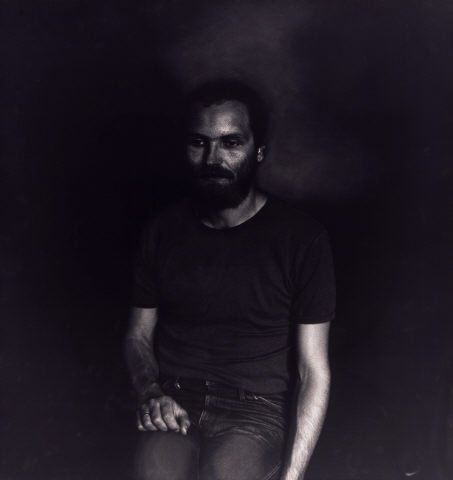
- 1988
- Photographic paper
- Photography
- Inv. 94FE46
Craigie Horsfield
Leszek Mierwa, ul. Nawojki, Kraków, August 1984
Craigie Horsfield appeared as a photographer – with a first solo exhibition in Cambridge –, in the same year and for the same occasion, when he printed the photograph of the Polish worker Leszek Mierwa, taken four years previously, in the summer of 1984, in Krakow. The black and white print of the image, in a large quadrangular format – an intentionally disciplining shape* –, of which the negative was destroyed, establishes, from this date, the principal themes of his unusual photographic work, which rapidly gained an international reputation. Horsfield is equally innovative in the ways his photographs are exhibited, sometimes employing the projection of images on multiple screens and the use of sound, which allow him to create photographic installations.
With an artistic education grounded in painting – at St. Martin’s School of Art, London, between 1969 and 1972, where he also studied photography –, Horsfield’s work constantly brings him back to painting. The game of distance-proximity between the two languages finds expression in the temporal hiatus which, in some images, separates the photographic register from its print; an interlude that implies creating a physical and critical distance between the time the image is captured and the time of its development and exhibition. It is also revealed in the extreme action that is the destruction of the negative, which makes the image, once printed, a unique image, eliminating the possibility of its reproduction and the cliché of the instantaneous tendency of photography to be seen as “the art of capturing a moment”. The desire to hide the image – also rendered in the game of chiaroscuro in which his models are enveloped –, the awareness of the infinite game with the visibility of the visible, and a precise perception of the witnessed historical moment, led him to delay the public presentation of his work until the end of the 1980s.
Craigie Horsfield considers photography to be partly responsible for the development of perception and of the human awareness of the real world and the changes that it faces. Quoting Nadar, he claims that the photographer must «morally grasp the subject».** However, he is aware that he only sees his models’ evidence of being and that is this register that endures through time. His portraits try to capture the tension between the awareness of the individuality of the portrayed subjects and the fact of their belonging to a social story, a collective body. The individual appears in the photographs as a discrete subject, anonymous, but not stereotyped. In this sense, a special importance is assumed by the images he took in 1984, during his revisit to Krakow – where he lived between 1972 and 1979 –, on the eve of the democratisation of the first Eastern Europe country to escape the control of the Iron Curtain. Already here his photographic work reveals his interest in a new social paradigm that prioritises private life, the “histories of life”, basing his conception of humanity on the treatment of the isolated individual. The world is this person, for example, Leszek Mierwa, whose individuality is paradoxically recognised and denied by the printed image.
Ana Vasconcelos
May 2010
* «Craigie Horsfield. A discussion with Jean-François Chévrier and James Lingwood», in Craigie Horsfield, London, Institute of Contemporary Arts, 1991, p. 10.
** Idem, p. 19.
| Type | Value | Unit | Section |
| Width | 140,5 | cm | |
| Height | 149,5 | cm | |
| Height | 162 | cm | |
| Width | 153,5 | cm |
| Type | Acquisition |
| Craigie Horsfield: Relation |
| Jeu de Paume |
| Curator: Jorge Molder |
| 15 de Março de 2007 a 3 de Junho de 2007 Museum of Contemporary Art, Sydney |
| 25 de Julho de 2006 a 24 de Setembro de 2006 Piso 1 do museu do CAM, Lisboa |
| 31 de Janeiro 2006 a 30 de Abril de 2006 Galerie Nationale du Jeu de Paume, Paris |
| Exposição organizada pela Galerie Jeu de Paume em colaboração com o CAMJAP/FCG e o Museum of Contemporary Art, Sydney.Comissariado: Régis Durand e Véronique Dabin com a assistência de Edwige Baron. |